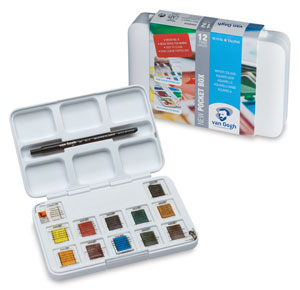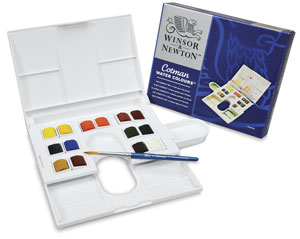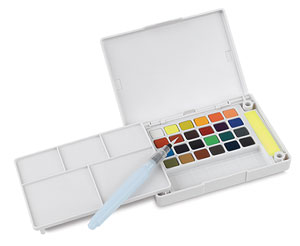July is #WorldWaterColorMonth! -- which makes it the perfect time to share and delight in all things watercolor!
It’s hard to believe that I was actually terrified of watercolors five or so years ago. My early illustration work relied on Copic and Prismacolor markers, and while they’re great at providing vibrant color, they couldn’t replicate the fluid, textural effects that I admired so much in the work of watercolor artists like Bil Donovan, Samantha Hahn and Helen Dealtry.
Getting comfortable with watercolor took some trial and error, in terms of finding the right materials and mastering the right techniques. A lot of pieces of paper with ugly splotches went into the recycling bin. But eventually, with a ton of experimenting and the help of a few tutorials, I came to love the medium. I now create the lion’s share of my work in watercolor.
When you’re getting started with watercolors, half of the battle is learning the right technique for handling the paints. But the best technique in the world can be hampered by not-so-great materials. Experienced artists can definitely make any medium work for them, but my philosophy is always -- why make your work harder? This is why I encourage my students to learn with quality supplies available at moderate prices.
When shopping for watercolors for the first time, you want to buy a set of pans that meets a few criteria. It should have:
a good range of colors to help you learn color mixing;
pigments that are rich and concentrated (not chalky), and won’t become dull and grainy on the paper;
a case with mixing wells that keeps everything compact and organized.
So here are a few suggestions for value-priced watercolor sets that will allow you to explore painting without breaking the bank.
I first experienced this set when friend at an illustration conference used them while taking a painting break. I noticed how easily he was able to mix the pigments and how vibrant the colors were. It wasn’t too long before I grabbed the Van Gogh set for myself, and I’ve got to say, these paint hold up pretty well next to my fancier, more expensive pigments. I adore the small, compact case, with six decent-sized wells for mixing. The 12 hues are more than enough to mix just about any color you need. It comes with a small travel brush, like many sets, but I never end up using it. I’m fine with carrying a few of my own synthetic brushes if I’m painting on the go. These are always my first recommendation for anyone experimenting with watercolor for the first time.
This set was on the supply list for my first illustration classes in fashion design school. I enjoy the Winsor & Newton Cotman set because of its range of colors. With 14 half pans, you get two versions each - typically a warm and a cool - of yellow, red, crimson/magenta, green and blue, plus your traditional neutral colors. It has mixing wells in the lid, as well as two cool pull-out compartments to give you more room for mixing. (I’m embarrassed to admit how long it took me to discover the pull-out palette!) The one big limitation of this set is that the mixing lid doesn’t lay flat. Sometimes the pull-out compartments can be a bit difficult to fiddle with, and I don’t find the colors to be quite as vibrant as the Van Gogh paints. I have used the travel brush that comes with the set, as it’s fairly sturdy. Overall it’s a good set to learn with.
This is my newest set of beginner-friendly watercolors. The Sakura Koi sets are available in 12, 24, 48 and 60-color versions and are truly designed for painting on-the-go, as they come with a few cool features. They include a small waterbrush (which I actually use!) and a pair of in-palette sponges, which allow you to clean your waterbrush between changing colors. It also comes with a fairly large palette that pops out and stands on its own. The 24-pan set provides a wonderful range of colors, though some colors perform better than others. The bright hues, like Lemon Yellow and Permanent Green Pale, come out beautifully vibrant. But others, like the Burnt Umber, are not quite as satisfying. One frustration I have with this set is that the cakes dry out fairly quickly, so I have to continually re-wet the colors while working. Still, you can’t beat the value of getting so many good-quality colors with a handy waterbrush to boot.
I have my favorites, but honestly, you can’t go wrong with any of the options above. The availability of good-quality, value-priced art supplies makes it easy to experiment with new techniques and materials. If you’re trying out watercolors for the first time, make sure to also pick up a pad of watercolor paper, to get the most out of your new paints!
And if you want to learn more about #WorldWatercolorMonth, check out the details here. Happy painting!
FTC NOTICE: This post contains affiliate links, from which I earn a small commission. All opinions are my own. I only discuss products I have used, and only endorse products that I truly enjoy.




